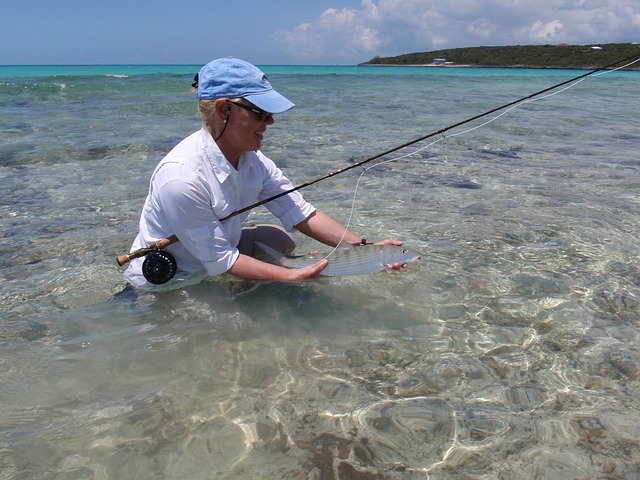The McKenzie River in Oregon is a premier destination for fly fishing, renowned for its abundant Rainbow Trout, Brown Trout, and Steelhead populations. With clear waters, diverse structures, and a range of fishing spots from tranquil to challenging, it caters to all skill levels. Anglers should adapt techniques based on season and water conditions, targeting dry flies in spring and nymphs in late summer. Accessing best McKenzie River fishing spots involves planning and understanding the river's terrain diversity, offering hiking trails, accessible banks, and remote pools. Spring and fall offer ideal conditions for catching trout using light tackle and top-quality flies; consider hiring a local guide for enhanced experiences.
Unwind and immerse yourself in the serenity of the McKenzie River, a paradise for fly fishers seeking unparalleled experiences. This intricate waterway boasts an abundance of native trout, making it a top destination for enthusiasts. From its tranquil banks to hidden coves, discover the best fishing spots along the scenic riverbank. Our guide unveils expert techniques, access points, and insider tips for a memorable journey into the heart of McKenzie River fishing spots.
- Exploring the McKenzie River's Abundant Fish Life
- Top Fishing Spots Along the Scenic Riverbank
- Techniques for Catching Native Trout in McKenzie
- Access Points: Getting to the Prime Fishing Areas
- The Ultimate Guide to a Memorable Fly Fishing Trip
Exploring the McKenzie River's Abundant Fish Life

The McKenzie River, winding its way through scenic Oregon, offers anglers an unparalleled experience with its abundant fish life. This river is home to a diverse range of species, making it a haven for fly fishing enthusiasts. From spring to fall, anglers can enjoy consistent catches of Rainbow Trout, Brown Trout, and even the elusive Steelhead. The clear waters provide excellent visibility, allowing for precise casting and an up-close view of the river’s vibrant ecosystem.
Exploring the McKenzie River’s fishing spots reveals hidden gems along its length. Whether you prefer tranquil sections ideal for beginners or fast-paced stretches challenging experienced anglers, this river caters to all skill levels. The river’s diverse structure, with shallow runs, deep pools, and scenic rapids, provides numerous habitats where fish congregate, making it a fly fisherman’s dream come true.
Top Fishing Spots Along the Scenic Riverbank

The McKenzie River, renowned for its stunning natural beauty, also offers anglers an unparalleled opportunity to enjoy world-class fly fishing. Along this scenic riverbank, several top fishing spots have emerged as hotspots for both resident and migratory fish species. One of the most popular destinations is the section near the picturesque Falls Creek, where the river’s current creates a rich environment for trout to thrive. Anglers can try their luck casting from the riverbank or even enjoy the challenge of fishing from a raft.
Further downstream, the river winds through lush forests, providing a tranquil backdrop for an exceptional fishing experience. This section is particularly renowned for its healthy population of rainbow and cutthroat trout, which make it a favorite among fly fishers. The diverse terrain along the McKenzie River ensures that each fishing spot offers unique challenges and rewards, making it a true paradise for enthusiasts seeking the perfect catch in a breathtaking setting.
Techniques for Catching Native Trout in McKenzie

When targeting native trout in the scenic McKenzie River, anglers should embrace various techniques to increase their chances of success. One effective method is utilizing dry flies during the spring and early summer months when the water levels are high. Presenting a floatant-enhanced dry fly near the surface will imitate emerging insects, enticing keen trout to strike. The McKenzie’s currents can be deceptively strong, so careful casting and precise presentation are key to ensuring your fly lands gently on the water.
For deeper waters during late summer and fall, switch to nymph fishing. This involves using a weighted line and sinkered nymphs, allowing them to descend below the surface and target trout feeding at greater depths. Experimenting with different nymph patterns inspired by local insect species can be highly effective. The McKenzie River offers diverse fishing spots, from shallow riffles to deep pools, providing anglers with numerous opportunities to master these techniques and land a memorable catch of native trout.
Access Points: Getting to the Prime Fishing Areas

Accessing the best McKenzie River fishing spots requires a bit of planning and knowledge of the terrain. The river’s meandering course offers numerous access points, allowing anglers to explore diverse sections teeming with wild trout. For those seeking a scenic adventure, hiking trails along the river provide a means to reach remote pools and riffles that are often overlooked by more casual visitors.
These fishing spots range from easy-to-access riverbanks suitable for beginners to challenging, off-the-beaten-path locations that cater to experienced anglers. Anglers can choose to wade in shallow areas where they can cast to rising trout or fish from a boat for a different perspective and access deeper waters. The variety of access points along the McKenzie River ensures that anglers of all skill levels can enjoy exceptional fly fishing opportunities.
The Ultimate Guide to a Memorable Fly Fishing Trip

Planning your next fly fishing adventure? The McKenzie River offers an unparalleled opportunity for anglers seeking a memorable trip. Here’s how to make it happen. First, explore the various McKenzie River fishing spots along this scenic stretch. Look for secluded pools and riffles hidden among lush greenery, where trout proliferate. Timing is key; spring and fall typically provide ideal conditions with cooler temperatures and abundant food sources.
Prepare for a truly immersive experience. Pack your fly gear, including top-quality flies and a light tackle setup suitable for the river’s currents. Consider enlisting the help of a local guide who knows the best spots and can teach you specialized techniques. With their expertise, you’ll enhance your chances of catching the prized rainbow or brown trout that call these waters home.
